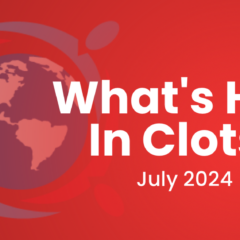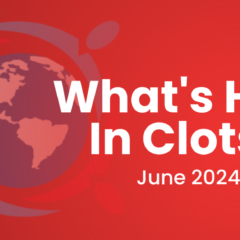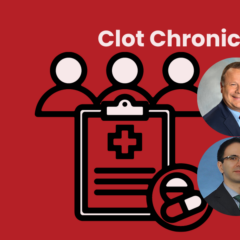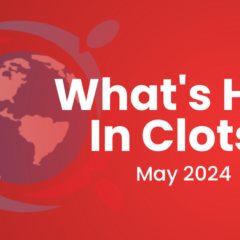Last updated on
Clot Chronicles: VTE Risk in the Hormonal Milieu
My name is Nathan Connell, and I’m a hematologist at the Brigham and Women’s Hospital and assistant professor of medicine at Harvard Medical School in Boston. On this episode of Clot Chronicles, I will be discussing venous thromboembolism in the hormonal milieu, which was a review article that my colleague, Dr. Jean Connors, and I recently published.
Hormonal therapy is well known as a risk factor for the development of thrombosis. And while the mechanisms are not entirely clear, we do know that hormones can lead to thrombosis through several pathways. Estrogen, for instance, increases circulating levels of several coagulation factors, including fibrinogen, factors II, VII, VIII, and X, as well as von Willebrand factor. Additionally, estrogen can change levels of C4b-binding protein, which, in turn, decreases free protein S, one of the body’s natural anticoagulants. And that ultimately leads to increased resistance to activate protein C.
We know that testosterone can lead to increased red cell masts and increased serum viscosity through an increased hematocrit. But additionally, adipose tissue can convert testosterone to 17β-estradiol which leads to the same coagulation factor changes seen with estrogen. The hormonal therapy that often gets the most press is the use of estrogen as part of combined hormonal therapy for contraception and control of heavy menstrual bleeding or abnormal uterine bleeding.
In a 2018 systematic review, it appeared that all forms of progestin-only methods had no increased risk of VTE, but injection of progestins appeared to potentially double the risk of thrombosis. This was in contrast to women using the levonorgestrel IUD in which the risk of thrombosis was the lowest. With estrogen, the dose and the route of administration matter. The higher the dose the higher the risk. Some data have suggested the estrogen-containing transdermal patch also has increased risk of VTE. But a recently approved patch appears to have low rates – less than 0.2% – which is encouraging. Vaginal rings do appear to increase the risk of thrombosis.
In terms of testosterone, some studies suggest no increased risk of VTE with testosterone. But a recently published case-control study suggested a higher VTE risk in men on testosterone, particularly men under the age of 65 without hypogonadism.
An important area where information is evolving and where we need good studies is how to mitigate the risk of thrombosis in transgender individuals receiving estrogen or testosterone as part of gender-affirming therapy. Transgender patients have a gender identity or expression that differs from what is typically associated with the sex assigned at birth, and hormonal therapy is a critical component of gender-affirming care. We have little data on how to guide our counseling and management of VTE risk.
In transgender women receiving estrogen, the VTE incidence rate appears to be about 2.3 per 1,000 person years. But the heterogeneity in the published studies makes it difficult to understand whether this applies to all transgender women. Surgery is a high-risk time period for thrombosis, and we have even less data for the risk of estrogen around the time of gender-affirming surgery for transgender women, as most of the published data for estrogen and surgery risk is based on formulations of estrogen not commonly used in transgender care. But it’s reasonable to extrapolate that VTE risk will follow a similar dose-dependent relationship, and that patients should receive postsurgical VTE prophylaxis. There’s a critical need for well-designed studies to answer these questions.
So, in summary, a few key points to take away. Estrogen increases the risk of venous thromboembolism in a dose-dependent manner, but the degree of risk is dependent on formulation, combination with specific progestin types, and specific patient factors such as obesity, age, and thrombophilias. The data on whether testosterone increases the risk of VTE is conflicting, and therapy should really be limited to treatment of hypogonadism whenever possible. And finally, transgender patients are at an increased risk of VTE while receiving gender-affirming therapy and should undergo individualized risk assessment with creation of specific mitigation plans to maximize the benefits of therapy while minimizing the thrombosis risk.



